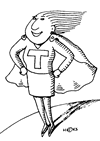Submitted for Graduation, May 2005
Important Understandings and/or Skills Developed in
the MI Program
Throughout the MI program, I have
developed understanding and skills.
I am going to explain three skills that have changed my
teaching.

1. Webpage
Creation
The most important skill
I developed in the MI program was learning how to create
webpages.
Before I started the MI program, I could only use Microsoft
Word. While take the course Internet Curriculum Applications, I
learned all of the basics in
creating webpages. From there, I began making webpages using
Netscape Communicator. I learned how to upload files, insert
images, and create links. Creating webpages was an easy task for
me. Then I began creating webpage after webpage.
I made a third
grade webpage for my class, a fourth grade
webpage, a webpage to host all of my graduate assignments,
an online
portfolio, and an online resume.
I taught other teachers how to make webpages. As I
continued through the program, I refined my skills. I continually
modified and changed my webpages. I am very proud to say that
this past semester I took EDUC 885, Advanced Multimedia Design. I
learned the basics of Dreamweaver and created a webpage from
scratch. I was able to use all I learned to improve my classroom
website. The learning I gained is apparent when comparing my first webpage
to the Dreamweaver
webpage. Learning how to create
webpages has also affected my students' learning. They use the
webpage on a daily basis to practice math facts, conduct research, and
extend their learning. Not only do they use the website in
school, but they also use the website at home. The webpage I
created not only enhances their learning, but it actively engages them
in their learning.
2.
Research
One of the most important understandings
I developed in the MI program was a new understanding of
research. I felt a sense of dread as I registered for EDUC 600,
Teacher as Researcher. I did not like reading research, and I was
not happy at the idea of conducting research. However, my
professor changed my understanding of research and showed me the
importance of research. In addition, as I read Living the
Questions: A Guide for Teacher-Researchers (1999), I began to learn
about
teacher-researchers. My old ideas vanished.
In their book, Hubbard and Power prove that “teaching is
research and research is teaching”
(p. 21). This book inspired and empowered
me. As I read the words of
teacher-researchers in
the midst of their studies, I realized that it was meant for
me. I
became a teacher-researcher and conducted research in my own
classroom! Hubbard
and Power state that “the best research questions are located in a
taut spot
between two points…once you find a gap that needs to be traversed…you
have
found territory in your classroom that is ripe for questioning” (p. 25). Through this inspiration, I allowed a
research question evolve. Then I collected and analyzed the
data. The process was
grueling but fascinating. The results of my research astonished
me. I was amazed by what my students taught me when I took the
time
to listen to what they were saying to me through their actions and
attitudes. My proudest moment was when I turned in my
final research paper called Engaging Students in Learning.
I never thought I could write such a paper. When my professor
told me that I should consider publishing the paper, I was
ecstatic. In fact, finishing my research paper and finishing that
class was
the catalyst for applying to the Ed. D program at UD. I now take
the
results of my research and apply it in my classroom everyday. I
also make sure I take the time to observe my students and determine
what they can teach me about my teaching.
3.
Technological Literacy
Before I entered the Master of
Instruction program, I was technologically illiterate. As I stated
above, I was only
able
use word processing programs. I rarely used
technology
in my classroom. I knew how to teach my students reading,
writing, and math, but I had no idea how to teach them to use
technology. The MI program truly gave me the technological
literacy I needed. Not only did I learn how to teach my students
to create PowerPoint presentations, but I learned how to teach my
students to navigate the web. I have educated my
students to safely use the internet. I also learned how to
integrate technology seamlessly
into my instruction. I have learned a variety of skills
that I needed to become a versatile teacher. In his book, Internet Literacy,
Hofstetter states, "The Internet is enabling students of all ages to
collaborate on worldwide projects, share discoveries, and develop
strategies for acquiring knowledge in a social context. It is
difficult for a teacher to provide this kind of environment for each
student in a traditional classroom. Since there is only one
teacher
for many students, it is physically impossible for a teacher to support
each student's individual needs. The World Wide Web helps by
providing
students with an interconnected world of knowledge to explore" (p.
26). This technological literacy has
transformed my teaching and has allowed me to meet the needs of all of
my
students. It has
helped remove my classroom walls, and I am now able to take my students
to places they could never go before.
References
Hofstetter, F. T. (2001). Internet Literacy. New York,
NY: McGraw-Hill Higher Education.
Hubbard,
R. & Power, B. (1999).
Living
the questions: A Guide for
teacher-researchers.
Clipart from Discovery School.